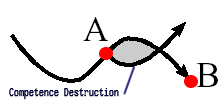Everything that is born
reaches a peak before the decline. But organisations do
have the option to renew themselves and thereby avoid the
inevitable decline.
Handy recalls a story of the
"Road to Davy's Bar"-" . . if you pass Davy's Bar, you've
gone too far !!", and from it draws the conclusion that:
"........by the time you
know where you ought to go, it's too late to go there,
or, more dramatically, if you keep on going the way you
are, you will miss the road to the future"
(Handy, 1994, p 49)
Handy went onto describe the
Sigmoid Curve, the curve which explains so many of our
present discontents and confusions. The curve describes
the ups and downs of one's life, or of a company, or even
of an empire. The secret of continued personal growth is
to start a new Sigmoid Curve before the old one begins to
peter out. As Handy explains:
"The right place to start
that second curve is at point A, where there is the
time, as well as the resources and the energy, to get
the new curve through its initial explorations and
flounder-ings before the first curve begins to dip
downwards"
(Handy,
1994, p. 51)

The best place to start a new
growth curve is at a point before the peak of the old one.
Unfortunately, identifying the peak is difficult and many
organisations leave it to too late. They try renewal when
the decline has started. Sometimes this works, but the
attrition rate for organisations that attempt renewal at
the downside of the curve is much higher than that for
those that begin renewal before the peak.
Unfortunately it is not easy
to know when the J section of the curve will end and the
top S section will begin. During the J phase, its very
difficult to push for change. Prevailing attitudes are:
Why rock the boat or the belief that if everything is
fine, were obviously doing the right things. The J phase
is a period of exponential growth that, when resources are
limited, is always followed by the S phase.
With changes occurring so
rapidly all round the world, organisations today just
cannot hope to hold on to their pre- eminent positions
unless they continually renew themselves every two-three
years. The days when companies had massive cost and
product advantages that enabled them to rule the roost for
several decades with little or no change, are gone
forever.
Today, more than ever, the
truth is that nothing is static: processes, products,
services, everything is changing and is in a constant
state of flux. Today's best operating practice is
tomorrow's dinosaur. How many of the In Search of
Excellence companies are still benchmarks for their
industries? As John Harvey Jones says, There is never a
perfect business simply one that is temporarily better
than its competitors. Managers, as individuals, tend to
see their job responsibility as being required to take
decisions, maintain productivity, to oversee, to
supervise, and hold a team together. The current realities
dictate that they need to do all of the above as well as
be the prime instruments of change and mobility. In the
coming few years, change
management will be the most sought after managerial skill.
![]()